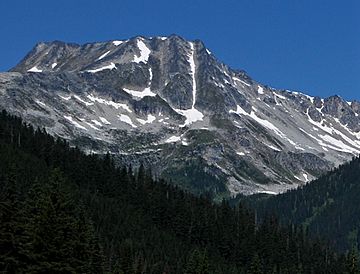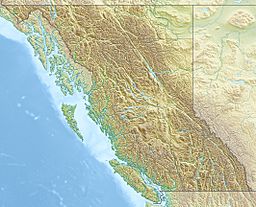Grizzly Mountain (Canada) facts for kids
Quick facts for kids Grizzly Mountain |
|
|---|---|

Grizzly Mountain, southeast aspect,
as seen from Rogers Pass |
|
| Highest point | |
| Elevation | 2,754 m (9,035 ft) |
| Prominence | 182 m (597 ft) |
| Parent peak | Mount Sifton (2922 m) |
| Geography | |
| Location | Glacier National Park British Columbia, Canada |
| Parent range | Hermit Range Selkirk Mountains |
| Topo map | NTS 82N/5 |
| Climbing | |
| First ascent | 1901 |
| Easiest route | class 3 Scrambling North Ridge |
Grizzly Mountain is a tall mountain peak in Glacier National Park, British Columbia, Canada. It stands at about 2,754 meters (9,035 feet) high. This mountain is part of the Hermit Range, which is a section of the Selkirk Mountains.
Grizzly Mountain is located about 57 kilometers (35 miles) northeast of Revelstoke. It is also 42 kilometers (26 miles) west of Golden. You can easily see it from the Trans-Canada Highway near Rogers Pass.
Exploring Grizzly Mountain
The first time people successfully climbed Grizzly Mountain was on August 31, 1901. A team of climbers named John E. Bushnell, August S. Eggers, Karl Schuluneggar, and Friedrich Michel reached the top. They climbed up the mountain's southeast side.
Later, in 1921, another group including Neal Carter, Tom Fyles, and Don Munday climbed the north ridge. In 1933, Georgia Engelhard and Ernest Feuz were the first to climb the west ridge.
Why the Name Grizzly Mountain?
The mountain got its name, Grizzly Mountain, in 1906. The name was officially approved again in 1932 by the Geographical Names Board of Canada.
It was named Grizzly Mountain because it is very close to a stream called Bear Creek. This creek was later renamed Connaught Creek. The name also fits with other nearby places that have bear-themed names. These include Ursus Major Mountain, Ursus Minor Mountain, Bruins Pass, and Balu Pass.
Mountain Climate
Grizzly Mountain is in a subarctic climate zone. This means it has very cold and snowy winters. The summers are usually mild.
During winter, temperatures can drop below -20 °C (-4 °F). With the wind chill, it can feel even colder, sometimes below -30 °C (-22 °F). Water from melting snow and a small glacier on the mountain's northwest side flows into the Beaver River and Illecillewaet River.



